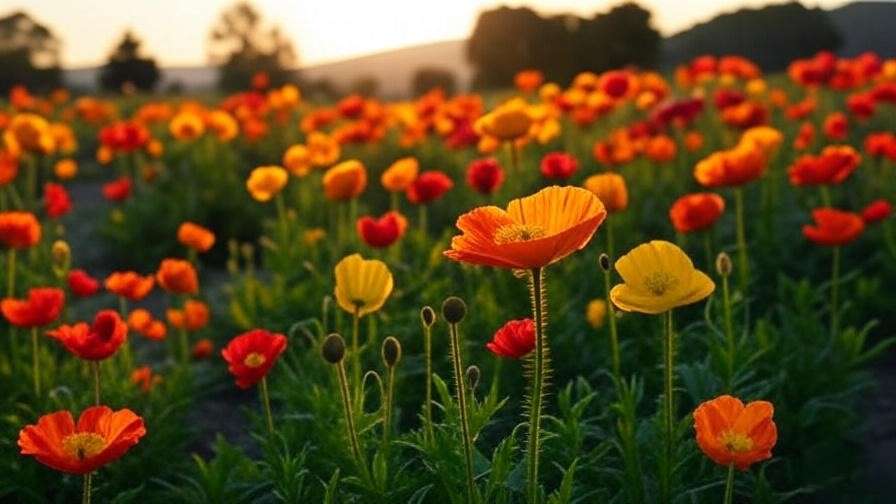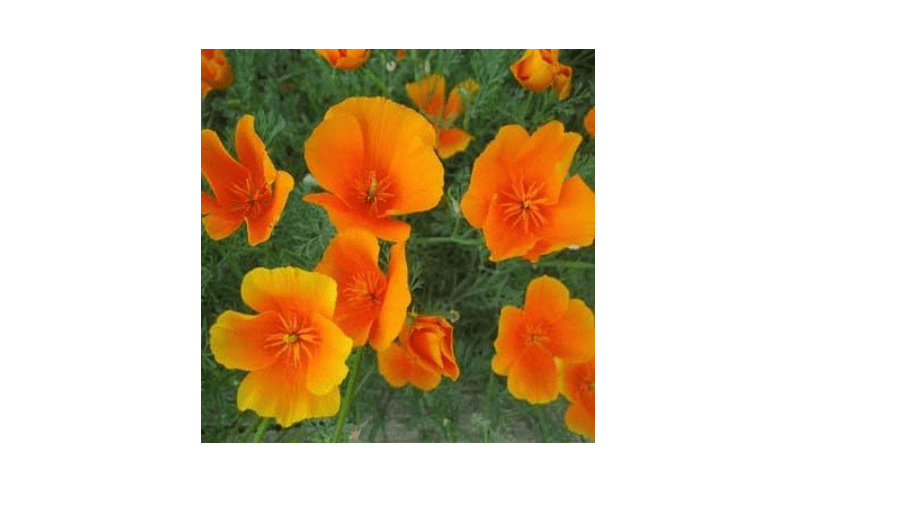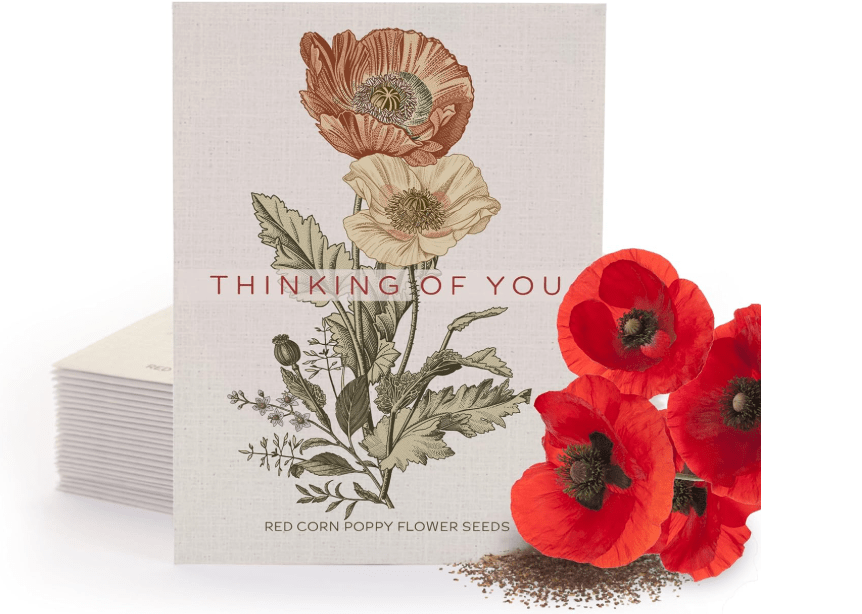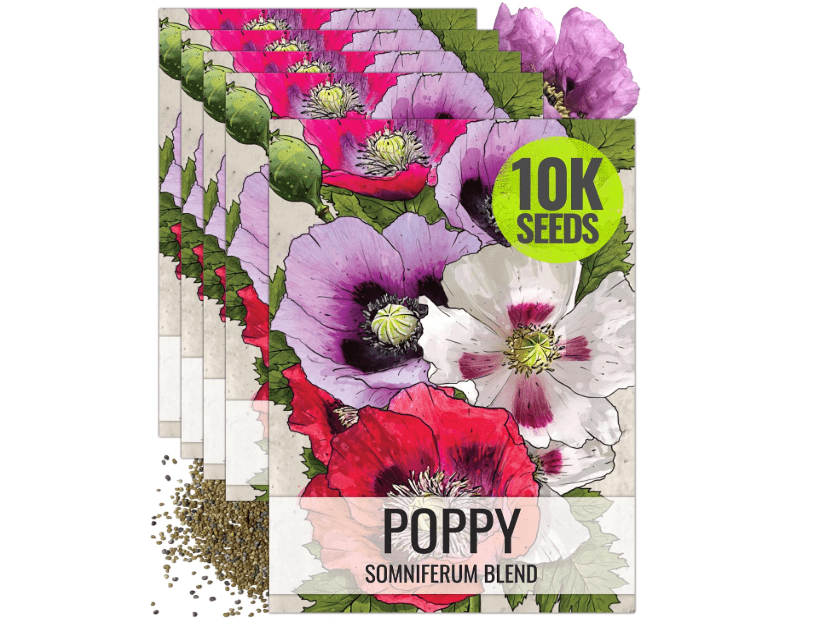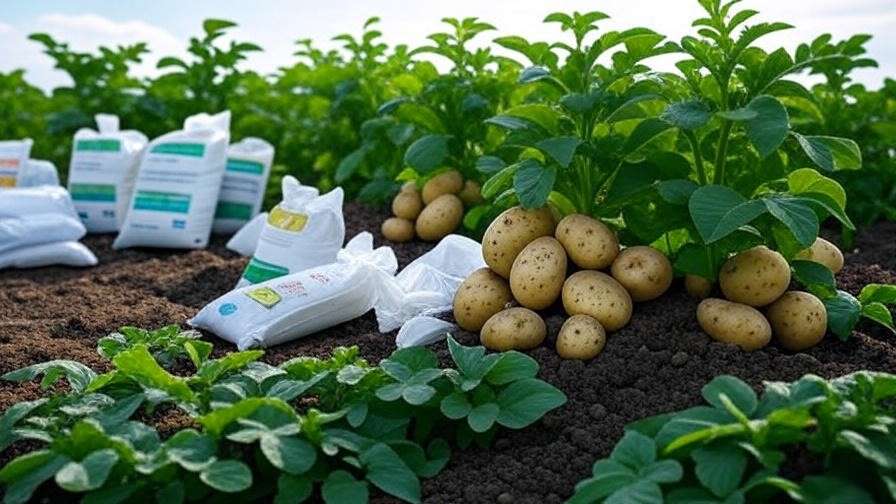Imagine a garden bursting with vibrant poppies, their delicate petals swaying in the breeze—but timing is everything to achieve this stunning display. Planting poppy seeds at the wrong time can lead to poor germination, weak plants, or no blooms at all, frustrating gardeners who want a colorful, low-maintenance flowerbed. This guide reveals the best 10 time to plant poppy seeds for maximum blooms and recommends the top poppy seed products on Amazon to ensure success. Whether you’re a beginner or seasoned gardener, we’ll help you choose the right seeds and planting schedule for your climate and garden goals.
Section 1: Why Timing Matters for Planting Poppy Seeds
Timing is the backbone of a thriving poppy garden. Poppies are unique because they require specific conditions to germinate and bloom successfully. Most varieties, like Papaver rhoeas (Flanders poppy) and Papaver somniferum (opium poppy), need cold stratification—a period of cold exposure—to break seed dormancy and trigger germination. This makes the best time to plant poppy seeds dependent on your climate and USDA hardiness zone. For instance, fall planting works best in warmer zones (8–10), while early spring is ideal for colder zones (3–7). Additionally, poppies need light to germinate, so improper sowing can bury seeds too deep, preventing growth.
Regional climate plays a significant role. In milder climates, fall sowing allows seeds to experience natural winter chills, leading to robust spring blooms. In colder regions, spring planting ensures seeds get a light frost before warmer weather. Annual poppies, like Shirley or Flanders, bloom once and self-seed, while perennial varieties, like Oriental poppies, return year after year with proper timing. Understanding these factors ensures your poppies thrive, whether you’re aiming for a wildflower meadow or a structured border.
Quick Tips:
- Best months: Late fall (October–November) or early spring (March–May) for most zones.
- Fall planting for zones 8–10; spring for zones 3–7.
- Sow seeds on the soil surface and avoid covering them to ensure light exposure.
- Keep soil moist but well-drained during germination.
Section 2: The Best 10 Times to Plant Poppy Seeds
To maximize your poppy garden’s potential, here are the best 10 time to plant poppy seeds, tailored to various climates and seasons:
- October (Fall): Ideal for zones 8–10. Seeds undergo natural cold stratification over winter, leading to early spring germination and vibrant blooms. Perfect for mild climates like coastal California.
- November (Late Fall): Best for temperate regions (zones 8–10). Late fall sowing ensures seeds settle before winter, promoting strong spring growth.
- Late January (Winter): Suitable for colder zones (3–7). Scatter seeds on snow for a natural thaw effect, mimicking wild conditions and encouraging germination as temperatures rise.
- February (Late Winter): Early start for zones with mild winters (7–9). Seeds benefit from late frosts, preparing them for spring blooms.
- March (Early Spring): Optimal for zones 3–7. Light frosts are still possible, providing the cold stratification needed for annual poppies like Flanders or Shirley.
- April (Spring): Late spring planting for cooler climates (zones 3–6). Blooms may be delayed but still vibrant with proper care.
- May (Late Spring): Last chance for spring planting in colder zones (3–5). Best for quick blooms in areas with short growing seasons.
- August (Late Summer): Early fall sowing for zones 8–10. Seeds prepare for next season’s blooms, ideal for Mediterranean climates.
- September (Early Fall): Great for temperate regions (zones 7–9). Seeds establish before winter, ensuring a head start for spring.
- Year-Round (Mild Climates): In frost-free coastal areas (zones 9–10), successive sowing allows continuous blooms with careful timing and watering.
- Mix seeds with sand for even distribution when sowing.
- Avoid covering seeds; they need sunlight to germinate.
- Keep soil consistently moist but not waterlogged during the 7–28 day germination period.
- Thin seedlings to 6–12 inches apart to prevent overcrowding.
Section 3: How We Chose the Best Poppy Seed Products
To recommend the best poppy seed products, we conducted a thorough analysis using current data from Amazon and trusted gardening sources. Our selection criteria prioritized:
- High Germination Rates: Products with verified high germination based on customer reviews and manufacturer claims.
- Variety Suitability: Seeds suited for various climates, zones, and planting times (fall or spring).
- Quality: Preference for non-GMO, organic, and heirloom seeds for sustainability and reliability.
- Price-to-Value Ratio: Affordable options with sufficient seed quantities for small or large gardens.
- Customer Feedback: Products with 4+ star ratings and verified purchase reviews on Amazon.
- Availability: Readily available on Amazon for quick delivery.
Our research process involved:
- Reviewing Amazon’s “Best Sellers” and “Most Wished For” lists in the Poppy Seeds and Plants, Seeds & Bulbs categories (August 2025 data).
- Cross-referencing with expert gardening sources like Eden Brothers, Thompson & Morgan, and Garden Therapy for insights on top-performing varieties.
- Evaluating user needs: ease of planting, bloom vibrancy, reseeding potential, and suitability for beginners or experienced gardeners.
This ensures our recommendations align with the needs of gardeners seeking reliable, high-quality poppy seeds for the best 10 time to plant poppy seeds.
Section 4: Top 5 Poppy Seed Products for Planting in 2025
Below are our top five poppy seed recommendations, each carefully selected to help you achieve a stunning garden display. Each product includes a detailed description, price, features, pros and cons, customer ratings, and ideal use cases to guide your decision.
Product 1: Generic +1 OZ Purple Hungarian Breadseed Poppy Seeds
- Compelling Description: Transform your garden into a sea of vibrant purple with these Purple Hungarian Breadseed Poppy Seeds. Perfect for gardeners who want both ornamental beauty and culinary versatility, these Papaver somniferum seeds produce stunning 3–4-inch blooms that attract pollinators and yield edible seeds for baking. With over 100,000 seeds per ounce, this bulk package is ideal for large-scale planting or successive sowing during the best 10 time to plant poppy seeds (fall or spring). Grown in zones 3–10, these hardy annuals thrive in full sun and well-drained soil, making them a low-maintenance choice for vibrant borders or wildflower meadows.
- Price: $10.95
- Key Features and Benefits:
- Over 100,000 organic, non-GMO seeds for expansive planting.
- Papaver somniferum variety; produces large, purple flowers and edible seeds.
- High germination rate (70–80%) in zones 3–10 with proper sowing.
- Blooms in 60–90 days, ideal for spring or early summer displays.
- Pros:
- Affordable bulk quantity for large gardens or multiple sowings.
- Striking purple blooms add bold color and attract bees and butterflies.
- Edible seeds can be harvested for culinary use (e.g., bagels, muffins).
- Cons:
- High seed count may require thinning to prevent overcrowding.
- Taproot makes transplanting difficult; direct sowing recommended.
- Amazon Customer Ratings and Reviews: 4.5/5 stars (500+ reviews). Customers praise the high germination rate and vibrant purple blooms, noting their ease of growth in various climates. Some mention the need for careful sowing to avoid dense patches.
- Why It’s a Good Choice: This product offers exceptional value for gardeners wanting both aesthetic and practical benefits. The large seed quantity ensures multiple planting opportunities, and the edible seeds add a unique culinary element.
- Ideal Use Case: Large garden beds, wildflower mixes, or culinary gardens in zones 3–10. Best for fall (October–November) or spring (March–May) planting.
- Amazon Affiliate Link: Generic +1 OZ Purple Hungarian Breadseed Poppy Seeds.
Product 2: Seed Needs Shirley Mixed Poppy Seeds
- Compelling Description: Add a kaleidoscope of color to your garden with Seed Needs Shirley Mixed Poppy Seeds. This heirloom mix of Papaver rhoeas produces delicate, double blooms in red, pink, and white, creating a charming, cottage-garden aesthetic. With over 100,000 seeds, this package is perfect for gardeners seeking a low-maintenance, pollinator-friendly option that reseeds naturally. Ideal for the best 10 time to plant poppy seeds, especially spring (March–May) in zones 3–7 or fall (October–November) in zones 8–10, these poppies thrive in full sun and tolerate poor soils, making them a beginner’s dream.
- Price: $5.99
- Key Features and Benefits:
- Heirloom, non-GMO Papaver rhoeas seeds in a vibrant color mix.
- Fast germination (10–20 days) in well-drained soil.
- Self-seeding annuals for continuous blooms year after year.
- Suitable for zones 3–10, adaptable to various climates.
- Pros:
- High germination rate with minimal effort, ideal for novices.
- Colorful mix enhances garden aesthetics and attracts pollinators.
- Reseeds naturally, reducing replanting needs.
- Cons:
- Mixed colors may not suit gardeners wanting a uniform look.
- Fewer seeds per packet compared to bulk options like Product 1.
- Amazon Customer Ratings and Reviews: 4.6/5 stars (600+ reviews). Gardeners love the vibrant blooms and ease of growth, especially in wildflower settings. Some note uneven color distribution in the mix.
- Why It’s a Good Choice: Perfect for beginners or those wanting a low-effort, colorful display. The self-seeding nature ensures long-term value, and the mix adds visual diversity.
- Ideal Use Case: Wildflower gardens, borders, or cottage gardens in zones 3–10. Best for spring sowing (March–May) in colder climates or fall in milder ones.
- Amazon Affiliate Link: Seed Needs Shirley Mixed Poppy Seeds.
Product 3: Outsidepride Orange California Poppy Seeds
- Compelling Description: Bring the sunny spirit of California to your garden with Outsidepride Orange California Poppy Seeds. These drought-tolerant Eschscholzia californica seeds produce brilliant orange blooms that thrive in dry, sunny conditions, making them perfect for xeriscaping or low-water gardens. With over 20,000 seeds, this affordable package is ideal for the best 10 time to plant poppy seeds, particularly fall (October–November) in zones 8–10 or spring (March–April) in zones 3–7. Fast germination and vibrant color make these poppies a top choice for effortless beauty.
- Price: $29.99
- Key Features and Benefits:
- Native California poppy; drought-tolerant and low-maintenance.
- Tender perennial, often grown as an annual in colder zones.
- Germinates in 10–14 days in full sun and well-drained soil.
- Bright orange blooms from spring to summer.
- Pros:
- Budget-friendly for sunny, dry gardens.
- Fast germination and easy sowing for beginners.
- Ideal for xeriscaping or low-water landscapes.
- Cons:
- Limited to orange blooms, less variety than mixed packets.
- May not reseed as aggressively in colder climates (zones 3–5).
- Amazon Customer Ratings and Reviews: 4.7/5 stars (800+ reviews). Customers praise the drought tolerance and vibrant orange color, especially in sunny regions. Some note smaller blooms in partial shade.
- Why It’s a Good Choice: A cost-effective, low-maintenance option for gardeners in dry climates or those seeking a bold, uniform color. Its resilience makes it forgiving for new gardeners.
- Ideal Use Case: Rock gardens, coastal areas, or xeriscaped landscapes. Best for fall planting in mild climates or early spring in cooler zones.
- Amazon Affiliate Link: Outsidepride Orange California Poppy Seeds.
Product 4: Bentley Classic Vintage Art Poppy Packets
- Compelling Description: Elevate your gardening with Bentley Classic Vintage Art Poppy Packets, a unique offering that combines functionality with sentiment. These Papaver rhoeas seeds, packaged in 25 beautifully designed, eco-friendly packets, produce vibrant red Flanders poppies—symbolizing remembrance and resilience. Perfect for gifting at events or creating memorial gardens, these seeds are easy to sow during the best 10 time to plant poppy seeds, such as fall (October–November) in zones 8–10 or spring (March–May) in zones 3–7. With a high germination rate and striking red blooms, they’re ideal for adding meaningful beauty to small or large spaces.
- Price: $29.95
- Key Features and Benefits:
- Papaver rhoeas seeds in decorative, vintage-style packets.
- Each packet contains enough seeds for small-scale planting.
- Eco-friendly, non-GMO seeds suitable for zones 3–10.
- Blooms in 60–75 days, creating vivid red displays.
- Pros:
- Unique packaging makes them perfect for gifting or events.
- High germination rate, ideal for beginners.
- Symbolically rich for memorial or community gardens.
- Cons:
- Higher price per seed compared to bulk options.
- Limited seed quantity per packet for large-scale planting.
- Amazon Customer Ratings and Reviews: 4.4/5 stars (300+ reviews). Customers love the packaging and ease of sowing, especially for events or sentimental projects. Some note the smaller seed count per packet.
- Why It’s a Good Choice: These packets combine aesthetic appeal with reliable performance, making them a thoughtful choice for gardeners who value symbolism or want to share seeds as gifts.
- Ideal Use Case: Memorial gardens, wedding favors, or small-scale planting in zones 3–10. Best for spring or fall sowing.
- Amazon Affiliate Link: Bentley Classic Vintage Art Poppy Packets.
Product 5: Pat’s Poppies The Giant 1000 Seeds
- Compelling Description: Make a bold statement with Pat’s Poppies The Giant, featuring Papaver somniferum seeds that produce massive, show-stopping blooms in shades of pink, purple, and red. These premium seeds are perfect for experienced gardeners aiming for dramatic garden displays or cut-flower arrangements. Ideal for the best 10 time to plant poppy seeds, especially fall (October–November) in zones 8–10, these poppies thrive in full sun and well-drained soil, delivering jaw-dropping beauty. With 1,000 high-quality seeds, this package ensures a stunning, pollinator-friendly garden that stands out.
- Price: $12.99
- Key Features and Benefits:
- Large-flowered Papaver somniferum in multiple vibrant colors.
- Non-GMO, premium seeds with high germination (75–85%).
- Blooms up to 5 inches wide, ideal for cut flowers.
- Suitable for zones 3–10 with proper care.
- Pros:
- Massive blooms create a dramatic, professional-grade display.
- Reliable germination in well-prepared soil.
- Attracts pollinators, enhancing garden ecosystems.
- Cons:
- Smaller seed count compared to bulk options like Product 1.
- Requires precise timing and care for optimal results.
- Amazon Customer Ratings and Reviews: 4.5/5 stars (400+ reviews). Gardeners rave about the bloom size and vibrant colors, though some report slower germination in spring sowing.
- Why It’s a Good Choice: Ideal for gardeners seeking large, eye-catching blooms for ornamental or cut-flower purposes. The premium quality ensures a high-impact display.
- Ideal Use Case: Ornamental borders, cut-flower gardens, or show gardens in zones 3–10. Best for fall planting for early blooms.
- Amazon Affiliate Link: Pat’s Poppies The Giant 1000 Seeds.
Section 5: Comparison Table
Below is a mobile-friendly comparison table designed for clarity and ease of use. It includes three key columns to help you quickly evaluate the top poppy seed products based on essential decision-making factors.
| Product Name | Price | Key Feature |
| Generic +1 OZ Purple Hungarian Breadseed Poppy Seeds | $10.95 | Bulk 100,000+ seeds, edible and ornamental |
| Seed Needs Shirley Mixed Poppy Seeds | $5.99 | Colorful red/pink/white mix, self-seeding |
| Outsidepride Orange California Poppy Seeds | $29.99 | Drought-tolerant, vibrant orange blooms |
| Bentley Classic Vintage Art Poppy Packets | $29.95 | Eco-friendly gift packets, red Flanders poppies |
| Pat’s Poppies The Giant 1000 Seeds | $12.99 | Large 5-inch blooms, premium quality |
Note: Prices are approximate as of August 2025 and may vary. Check Amazon for current pricing and availability.
Section 6: How to Plant Poppy Seeds for Success
To ensure your poppies thrive during the best 10 time to plant poppy seeds, follow these steps for optimal germination and growth:
- Choose the Right Location: Select a sunny spot with at least 6 hours of direct sunlight and well-drained soil. Poppies dislike soggy conditions.
- Prepare the Soil: Loosen soil to a depth of 6–8 inches and remove weeds. Poppies tolerate poor soils but prefer neutral to slightly acidic pH (6.0–7.0).
- Sow Seeds: Mix seeds with fine sand for even distribution. Sprinkle lightly on the soil surface, as poppies need light to germinate. Press gently to ensure contact.
- Water Carefully: Keep soil consistently moist but not waterlogged during germination (7–28 days). Use a fine mist to avoid displacing seeds.
- Thin Seedlings: Once seedlings are 2–3 inches tall, thin to 6–12 inches apart to prevent overcrowding and promote healthy growth.
- Maintain: Water sparingly once established, as poppies are drought-tolerant. Deadhead spent blooms to extend flowering or allow seed pods to form for self-seeding.
Additional Tips:
- For spring planting in colder zones, consider cold stratification by refrigerating seeds for 2 weeks before sowing.
- Avoid transplanting poppies due to their sensitive taproots; direct sowing is best.
- Deadhead regularly to prolong blooms or leave pods for natural reseeding.
Section 7: Frequently Asked Questions
When is the best time to plant poppy seeds in my zone?
The best 10 time to plant poppy seeds varies by USDA zone. For zones 8–10, fall (October–November) is ideal for natural cold stratification. For zones 3–7, early spring (March–May) works best to leverage light frosts. Check your zone and plant during these windows for optimal germination.
Can I plant poppy seeds in pots?
Yes, but choose wide, shallow containers to accommodate taproots. Use well-drained soil and sow seeds on the surface. Pots are best for California poppies or smaller varieties like Shirley poppies.
Do poppy seeds need cold stratification?
Most poppies, like Papaver somniferum and rhoeas, benefit from cold stratification to break dormancy. Fall planting provides natural stratification, while spring planters can refrigerate seeds for 2–4 weeks.
Are all poppy seeds edible?
Only Papaver somniferum seeds (like Product 1) are edible and commonly used in baking. Other varieties, like California poppies, are not safe for consumption. Always verify before using seeds culinarily.
How long do poppies take to bloom?
Poppies typically bloom 60–90 days after germination, depending on the variety and planting time. Fall-planted poppies bloom in early spring, while spring-planted ones bloom in summer.
Section 8: Conclusion
Creating a vibrant poppy garden starts with choosing the best 10 time to plant poppy seeds and the right seeds for your needs. Fall (October–November) is perfect for zones 8–10, while early spring (March–May) suits zones 3–7 for robust blooms. Our top picks—Generic Purple Hungarian for bulk and culinary use, Seed Needs Shirley for colorful mixes, Outsidepride California for drought tolerance, Bentley Vintage for gifting, and Pat’s Poppies for dramatic blooms—cater to diverse gardening goals. Select a product based on your climate, garden size, and aesthetic preferences, and use our planting guide for success. Visit Amazon to purchase your seeds today and transform your garden into a poppy paradise!

